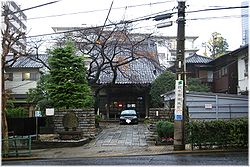- Daishin-ji
-
Hōtōzan Hōju-in Daishin-ji (宝島山峯樹院大信寺), or more briefly Daishin-ji, is a Buddhist temple of the Jōdo sect in Minato, Tokyo, Japan. In 1611, the founder, Ryō-kō Shōnin, was given land for the temple in Minami Hatchōbori by the Tokugawa shogunate. The temple was originally named Hōtōzan. In 1635, it was relocated to its present site in Mita 4 chōme by order of the government, to accommodate the continuing expansion of Edo. In 1636, Ishimura Genzaemon (considered the first shamisen craftsman in Edo) was buried in the temple. From Ishimura Omi, the graves of eleven generations of the family were also constructed there. For this reason, the temple is sometimes nicknamed "The Shamisen Temple."
External links
- Daishin-ji Web site (in Japanese)
35°38′37″N 139°44′13″E / 35.643583°N 139.736931°ECoordinates: 35°38′37″N 139°44′13″E / 35.643583°N 139.736931°E
Buddhist temples in Japan Japanese Buddhist architecture Architectonic elements Mon (gates) Buildings Chinjusha · chōzuya/temizuya · -dō · main hall (kon-dō, hon-dō, butsuden) · kuri · kyōzō or kyō-dō · shoinTō or Buttō (pagodas) Styles Others A-un · kenSchools and objects of worship Major schools Zen schools Nanto rokushū Objects of worship Amida Nyōrai · Benzaiten · Dainichi Nyorai · Jizō · Kannon · Marishi-ten · Shaka Nyorai · Shitennō (Four Kings) · Twelve Heavenly Generals (Jūni Shinshō) · Yakushi NyoraiOther elements Implements kei (ritual gong) · mokugyōOthers bussokuseki · butsudan · Glossary of Japanese Buddhism · Japanese Buddhist pantheon · jingū-ji · miyadera · saisenbakoCategories:- Minato, Tokyo
- Buddhist temples in Tokyo
- Japanese building and structure stubs
- Tokyo geography stubs
Wikimedia Foundation. 2010.

